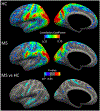Associations between corpus callosum damage, clinical disability, and surface-based homologous inter-hemispheric connectivity in multiple sclerosis
- PMID: 35536387
- PMCID: PMC9850837
- DOI: 10.1007/s00429-022-02498-7
Associations between corpus callosum damage, clinical disability, and surface-based homologous inter-hemispheric connectivity in multiple sclerosis
Abstract
Axonal damage in the corpus callosum is prevalent in multiple sclerosis (MS). Although callosal damage is associated with disrupted functional connectivity between hemispheres, it is unclear how this relates to cognitive and physical disability. We investigated this phenomenon using advanced measures of microstructural integrity in the corpus callosum and surface-based homologous inter-hemispheric connectivity (sHIC) in the cortex. We found that sHIC was significantly decreased in primary motor, somatosensory, visual, and temporal cortical areas in a group of 36 participants with MS (29 relapsing-remitting, 4 secondary progressive MS, and 3 primary-progressive MS) compared with 42 healthy controls (cluster level, p < 0.05). In participants with MS, global sHIC correlated with fractional anisotropy and restricted volume fraction in the posterior segment of the corpus callosum (r = 0.426, p = 0.013; r = 0.399, p = 0.020, respectively). Lower sHIC, particularly in somatomotor and posterior cortical areas, was associated with cognitive impairment and higher disability scores on the Expanded Disability Status Scale (EDSS). We demonstrated that higher levels of sHIC attenuated the effects of posterior callosal damage on physical disability and cognitive dysfunction, as measured by the EDSS and Brief Visuospatial Memory Test-Revised (interaction effect, p < 0.05). We also observed a positive association between global sHIC and years of education (r = 0.402, p = 0.018), supporting the phenomenon of "brain reserve" in MS. Our data suggest that preserved sHIC helps prevent cognitive and physical decline in MS.
Keywords: Clinical; Corpus callosum; Inter-hemispheric functional connectivity; Multiple sclerosis; Resting state.
© 2022. The Author(s), under exclusive licence to Springer-Verlag GmbH Germany, part of Springer Nature.
Figures





References
MeSH terms
Grants and funding
LinkOut - more resources
Full Text Sources
Medical

